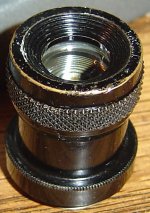Autocollimator components . . .
shanej45,
You will have a nice system when you find/make the following:
o An eyepiece.
o A light source.
o One or more mirrors.
o Perhaps an optical square.
The search for an eyepiece will take some patience and will be greatly helped if someone with a similar autocollimator will help define what you are looking for. The fact that your eye-piece-less unit has a micrometer for shifting the eyepiece is good news because it means that you do not need an eyepiece with a graduated reticule in it. In old autocollimators, the reticule allowed measurement by direct reading -- more advanced models used the micrometer. Some had both X and Y micrometers, but you can make an X measurement and then rotate the micrometer unit ninety degrees and then make a Y measurement. Anyway, the first step in the search for an eyepiece is to measure and post the diameter of the hole the eyepiece fits.
Regarding the light source, most autocollimators had a lamp house that dealt with mounting an incandescent light bulb and dealing with the heat it generated. A power supply was also needed. Many hobbiests have converted their autocollimators to use a LED (light emitting diide), which is better in all regards. The light from an LED is already unidirectional, so no condensing lens is needed. I took my set of measurements with a jury-rigged white LED pocket flashlight. The red plastic plug is keeping dust out of the hole where your light source mounts. I recommend you look for a small white LED flashlight that is slightly smaller than this hole. You may need to mount a small piece of frosted class to diffuse the light, but that may already be in place.
I purchased a one 1/10th wavelength first surface mirror from Edmund Optical for making my first mirror. 1/4 wavelength flatness may be acceptable for an autocollimator, but I read differing opinions on this, so I went with the flatter mirror. Later on, I will discuss my mirror mounting ideas. If you are going to survey a surface plate, you will need at least one mirror to move along straight-line paths. A second mirror, used as a "turning mirror" makes things more efficient by removing the need to relocate the autocollimator for each line of measurements. The most common pattern is called the "Union Jack" because of its similarity to the British flag, but any pattern that has a lot of lines parallel to the edges, al few diagonals (to check for twist) and covers the surface thoroughly will be fine. The pros have a very, very heavy tripod so as to mount the autocollimator off the surface plate, but you can rig almost anything so long as you have a very stable mount.
An optical square is only necessary if you are checking surfaces like machine tool ways for squareness. If you are testing a square on your surface plate, then an optical square might be useful. An optical square and mirrors can cost as much as the autocollimator itself, but if you are patient, you can find these things on eBay and other places. The best buys come from sellers that are not even certain what they are selling. My Taylor-Hobson autocollimator was listed on eBay by a professional camera outlet as a "telescope suitable for bird-watching",with no mention of the word autocollimator.
I am a beginner in the field of applying an autocollimator, so I would welcome correction of any misunderstandings on my part.
Archie
P.S.: This thread fits the measurement forum, but perhaps is best here because many more people are reading this forum. Most folks do consider an autocollimator to be an antique . . .








